NOTES
ABOUT THIS PUBLICATION
Barriers and Incentives to Labour Force Participation focuses on people who are 18 years and over who are either not employed or work very few hours (0-15 hours). The survey includes only those working less than 16 hours, rather than all part-time workers, as they have the potential to increase their labour force participation by a greater amount. The data collected provides information on the potential labour force and the characteristics of that potential labour force. Data from this survey are used to obtain a better understanding of the factors that influence people to join or leave the labour force. By knowing the barriers people face to joining the labour force or taking up (more) employment, a range of incentives to labour force participation can be indirectly identified.
The statistics in this publication were compiled from the Multi-Purpose Household Survey (MPHS), conducted throughout Australia from August 2004 to June 2005 as a supplement to the Australian Bureau of Statistics (ABS) monthly Labour Force Survey.
The other topics collected in the 2004-05 MPHS were:
DATA NOTES
The MPHS was designed primarily to provide estimates at the Australia level. Broad estimates are also available for states and territories, although users should exercise caution when using estimates at this level, because of the presence of high sampling errors.
Estimates in the electronic tables have been presented to the nearest 100, but the underlying numbers have been set at six decimal places to allow users the flexibility to calculate proportions or aggregate estimates. Many of the statistics included in the tables are subject to large sampling error. For instance, users should exercise caution when using estimates in the tables containing detailed age ranges. Detailed age ranges have been presented to allow users the flexibility to aggregate age ranges according to their needs. Many of the estimates presented in the tables should not be used unless they are aggregated to give more reliable estimates. Users should take note of the corresponding Relative Standard Errors (RSEs) to determine the reliability of the estimates and whether they are appropriate to use. For further information about the reliability of estimates see paragraph 13 of the Explanatory Notes. For details about how to calculate RSEs for estimates which have been aggregated see paragraphs 9 to 15 of the Technical Note.
ROUNDING
As estimates have been rounded, discrepancies may occur between sums of the component items and totals.
INQUIRIES
For further information about these and related statistics, contact the National Information and Referral Service on 1300 135 070 or Labour Market Statistics Section on Canberra (02) 6252 7206.
SUMMARY COMMENTARY
CONCEPTUAL FRAMEWORK
OVERVIEW
In understanding the barriers to labour force participation there are several groups of people who are of particular interest. These are the unemployed, persons not in the labour force and those who usually work relatively few hours (0-15 hours). For persons not in the labour force and those who usually work few hours it is important to ascertain whether they would like a paid job or more hours, whether they are available to start work, and whether they are looking for work.
SUMMARY OF FINDINGS
OVERVIEW
The 2004-05 Multi-Purpose Household Survey (MPHS) revealed that of the 15.1 million people aged 18 years and over, 9.7 million (64%) were employed, 465,000 (3%) were unemployed and 4.9 million (32%) were not in the labour force. Of those employed, 951,700 (10%) usually worked relatively few hours per week, that is, between 0 and 15 hours. Women comprised the majority of this group and of those not in the labour force (75% and 64% respectively), while more men than women were unemployed (56%).
Of the 6.3 million people not employed or who worked few hours, approximately 1.8 million (or 28%) indicated that they would like a job or more hours. This group comprised:
- 321,700 (or 18%) people who usually worked few hours per week;
- 465,000 (or 26%) people who were unemployed; and
- 977,300 (or 55%) people who were not in the labour force.
The remaining 4.5 million people (or 72%) did not want a job or did not want to work more hours, or were undecided.
The 6.3 million people who were unemployed, not in the labour force or working few hours have various reasons for not participating, or not participating fully, in the work force which are considered barriers to participation in the labour force. To better understand these barriers, information was collected on the reasons people are not fully participating in the labour force. By understanding such barriers to labour force participation, a range of incentives can also be indirectly identified.
PEOPLE WHO WANTED A JOB OR MORE HOURS
Of the 1.8 million people who wanted a job or preferred more hours:
- 348,500 people indicated that they were not available to start a job, or work more hours, within four weeks;
- 813,700 were not looking for work (includes 25,300 persons who were also not available); and
- 627,000 people were available and looking for work or more hours.
Women represented the largest proportion of those who wanted a job or more hours (62%), which is consistent with the fact that more women are underemployed or not in the labour force1.
Not available to start a job or work with more hours
Determining whether those who are not employed or who work few hours are available to work is important because those who are available have a greater potential to increase labour force participation than those who are not available. Of the 1.8 million people who were not employed or who worked few hours and wanted a job or more hours, 1.4 million (80%) were available to start work within four weeks. The remaining 348,500 people (20%) were not available. People not in the labour force represented approximately 92% of those not available, while the remaining 8% comprised people who worked few hours. About two thirds (232,900 or 67%) of those who were not available were women.
Men and women who were not in the labour force had different reasons why they were not available to start work within four weeks. Of the 107,100 men not in the labour force who wanted to work, the main reasons for not being available were long-term sickness or disability (55% or 58,900), followed by short-term sickness or injury (10% or 10,600). In contrast, a large proportion of the 213,100 women not in the labour force who wanted a job were not available due to child care, pregnancy or home duties (46%), followed by long-term sickness or disability (16%), and studying commitments (13%).
People not in the labour force who wanted a job but were not available(a), Main reasons for not being available
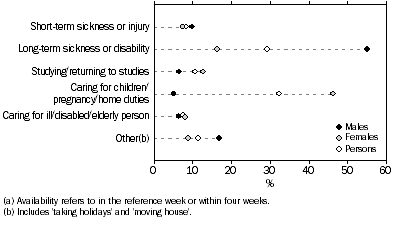
Different reasons for not being available to work were also apparent among different age groups. For instance, a large proportion of people not in the labour force aged 25-44 (mainly women) who wanted to work, reported child care, pregnancy or home duties as the main reason that they were not available (61%); while a large proportion of young people (18-24 years) were not available due to study commitments (70%); and many of those aged 45 years and over were not available due to long-term sickness or disability (46%). Such differences reflect the various stages of life which can affect labour force participation.
People not in the labour force who wanted a job but were not available(a), Age by selected main reasons for not being available
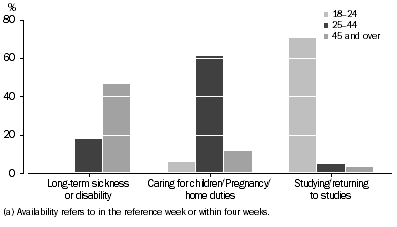
Not looking for a job or work with more hours
Details about whether people were looking for work were collected from all employed people who worked few hours and wanted to work more (regardless of whether they were available), and from people not in the labour force who wanted to work and were available to work. Of the 1.8 million people who were not employed or who worked few hours and wanted a job or more hours, an estimated 813,700 people (46%) indicated that they were not looking for a job or more hours. Most of this group were women (574,100 or 71%) and most were not in the labour force (642,700 or 79%).
Like those who were not available, the most common reason for not looking for work, or more hours, was due to caring for children, pregnancy or home duties (22% or 180,900 people). Once again, women comprised the majority of this group (89% or 160,500) and people who gave those responses were most concentrated in the 25-44 year age group (70% or 126,100). Over 40% of people in this age group were not looking for work, or more hours, due to this reason. Another common reason given for not looking for work, or more hours, was studying or returning to studies (13% or 106,000 people). Of people who gave study as their main reason for not looking for work, most (69% or 73,000) were aged between 18 and 24, with 52% of this age group citing it as their main reason. Being considered too old by employers was given as the main reason for not looking for work, or more hours, by 9.7% of those who were not looking. Of people who gave this as their main reason 92% (or 72,600) were aged 55 years and over, with 30% of this age group citing it as their main reason.
Looking and available to start a job or work with more hours - difficulties encountered
There were 627,000 people who were available to start a job, or work more hours, and were looking for work, of which:
- 465,000 were unemployed (74%);
- 147,700 usually worked few hours (24%);
- 14,400 were not in the labour force (2%) (these people are defined as not in the labour force because they were not available to start work in the reference week, but were available to start within four weeks).
There were varied responses from those people who were available and looking for a job or work with more hours regarding the difficulties they have in finding a job or work with more hours. Overall, the main difficulty reported by this group was that they lacked the necessary training, qualifications and experience (106,800 people or 17%). Over 60% (or 67,700) of the people who reported this as their main difficulty held no non-school qualifications, of which 43% were aged 18 to 24. No jobs with suitable conditions was also a commonly reported difficulty (80,200 people or 13%), of which 62% were women. Most of those who reported unsuitable conditions as a difficulty in obtaining work, or more hours, were aged 18-44 years (71,800 or 90%), which may reflect a need for more flexible working arrangements due to education and family responsibilities. Approximately 44% (or 35,700) of those who reported their main difficulty as being considered too old by employers were aged 55 years and over, and 60% of this group were men. This reflects the larger proportion of men aged 55 years and over who were available and looking for work or more hours (14% of men compared with 8% of women).
People available and looking for a job or work with more hours, Selected main difficulties
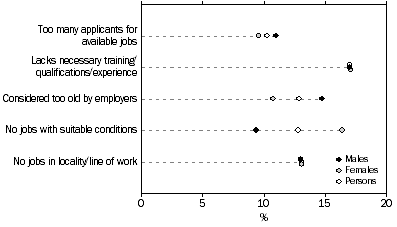
Preferred weekly hours
The preferred number of hours of work were collected from people not in the labour force who wanted a job and people who usually worked few hours and wanted to work more. Men and women who usually worked 0 to 15 hours per week displayed different preferences in the number of hours they would like to work. Among the 95,500 men who wanted more hours, 62,400 (65%) indicated that they would like to work full-time hours (35 hours or more). In contrast, a greater proportion of women preferred to work part-time hours (68% or 154,400 women). Older people who usually worked 0 to 15 hours preferred to work less hours than their younger counterparts. For instance, the average preferred number of hours for people aged 55 years and over was 25 hours per week, compared with 30 hours for those aged 18 to 34 years.
Of the 977,300 people not in the labour force who wanted a job, 73% reported that they would prefer to work part-time hours (57% of men and 81% of women). The average preferred number of hours was 22 (25 hours for men and 20 hours for women).
PEOPLE WHO DO NOT WANT MORE WORK
Over 70% of people (or 4.5 million) who were not employed or who worked few hours indicated that they did not want a job or more hours. This comprised 630,100 people who usually worked few hours, and 3.9 million people not in the labour force. By definition all unemployed people wanted a job and were actively looking. Almost two-thirds (65%) of those who did not want a job or more hours were women.
The men and women who usually worked few hours and did not want to work more had very different characteristics and reasons for not wanting more hours. Approximately 45% (or 219,700) of women who did not want more hours were aged 25-44 years and 23% (or 110,700) were aged 55 years and over. The most common reason women gave for not wanting more hours was 'caring for children/pregnancy/home duties' (48% or 233,300 women gave this response). This was a major factor for women aged 25-44 with 85% (or 186,600) of them giving this as a reason for not wanting more hours. This indicates that part-time work is particularly important for women who are raising children. Other common reasons for women not wanting more hours were 'no need/retired from full-time work (for now) (24% or 118,800), with 56% of this group aged 55 years and over, and 'studying/returning to studies' (19% or 93,400) with 72% of this group aged 18-24 years.
Of the 141,600 men who usually worked few hours, 44% (or 62,100) were aged 18-24 years and 35% (or 50,200) were aged 55 years and over. The most common reason given for not wanting more hours was due to study commitments (40% or 56,200), which reflects the large proportion of men aged 18-24 who did not want to work more hours. Other reasons commonly reported were 'no need/retired from full-time work (for now)' (23% or 32,900), of which 83% were aged 55 years and over, and long-term sickness or disability (13% or 18,000), of which 59% were aged 55 years and over.
People who usually work few hours(a), Selected reasons for not wanting to work more hours(b)
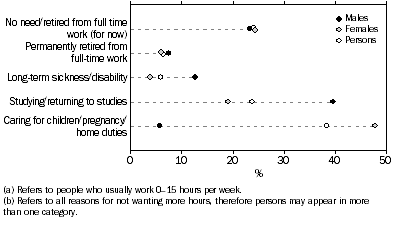
The age composition of people not in the labour force was quite different to people working few hours and it also differed for men and women. Of the 4.9 million people not in the labour force almost two-thirds (64%) were aged 55 years and over. Of men not in the labour force 75% were aged 55 and over. Of women not in the labour force 58% were aged 55 and over and 25% were aged 25-44.
The different age structure of people not in the labour force means that the reasons given for not wanting to work were quite different to the reasons given by those working few hours. Of the 3.9 million people not in the labour force who did not want to work, the most common reason for not wanting a job was due to being permanently retired (32% or 1.3 million), followed by no need/retired from work (for now) (30% or 1.2 million), and long-term sickness or disability (22% or 856,200). Long-term sickness or disability was reported by 31% of men (or 456,300) and was common for all age groups. Twenty-two per cent of women (or 546,900) also indicated that they did not want to work due to child care, pregnancy or home duties. Most of these women were aged 25-44 years (73%).
People not in the labour force, Selected reasons for not wanting a job(a)
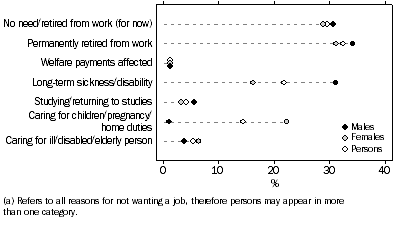
1Sources: Underemployed Workers, Australia (cat. no. 6265.0) and Persons Not in the Labour Force (cat. no. 6220.0).
 Print Page
Print Page
 Print All
Print All